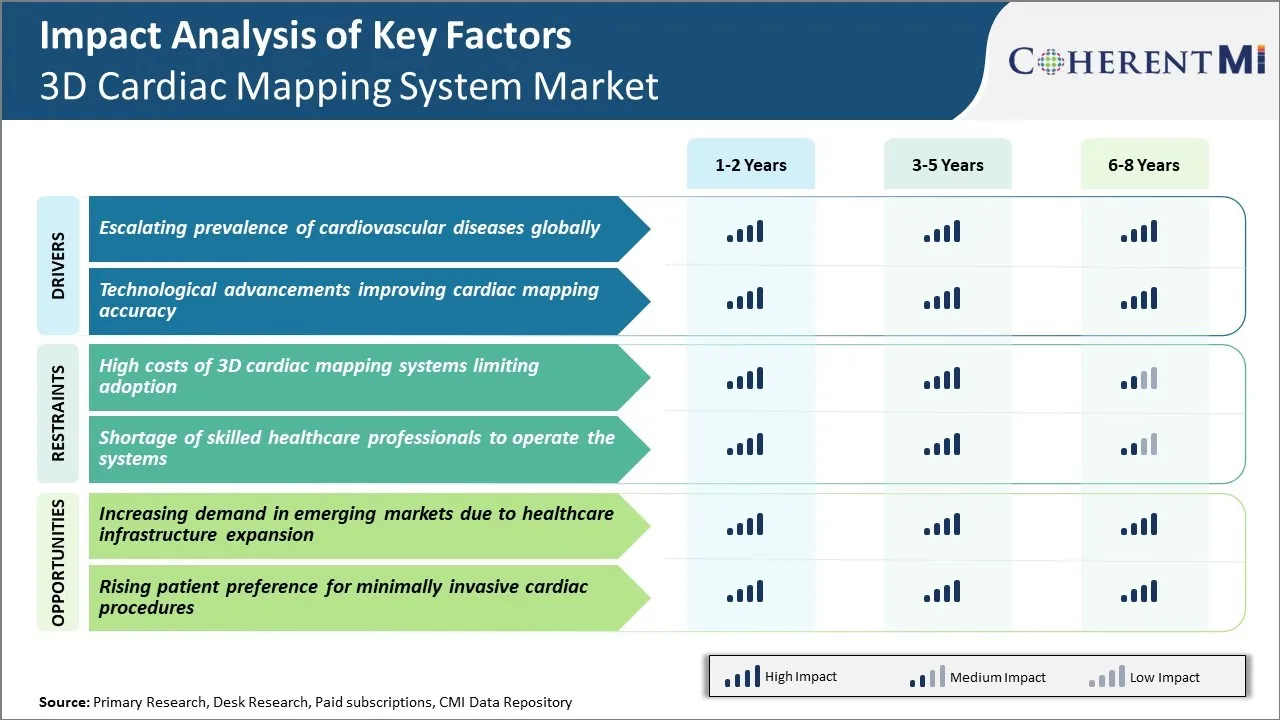3D Cardiac Mapping System Market Trends
Market Driver - Escalating Prevalence of Cardiovascular Diseases Globally
The American Heart Association estimates that by 2035, approximately 130 million American adults will be diagnosed with some form of cardiovascular disease. As per the WHO, cardiovascular diseases now claim more lives than any other causes globally and are projected to remain the single leading cause of death worldwide by 2030. With over 75% of cardiovascular deaths taking place in low and middle-income countries, this rising epidemic is devastating populations across both developed and developing regions.
The growing cardiovascular patient pool has exponentially increased the demand for more advanced diagnostic and treatment modalities. Cardiac mapping systems have emerged as an important technology for the precise visualization and 3D reconstruction of the heart's structure during complex ablation procedures. Their utility is further accentuated in the management of pediatric and congenital heart diseases which afflict a sizeable young demographic worldwide.
Great focus is being laid on innovative medical solutions that can optimize operational efficiencies, save costs and support better cardiac treatment outcomes at a wider population level. To summarize, the towering prevalence of heart disorders emerging as a leading cause of mortality makes a compelling case for the increasing dependence on advanced mapping technologies in the years ahead.
Market Driver - Technological Advancements Improving Cardiac Mapping Accuracy
Cardiac mapping systems have come a long way driven by relentless innovation in the medical devices arena. Early basket catheters relying on basic localization of electrical signals have now advanced into high-density multi-electrode mesh platforms along with integration of non-contact mapping capabilities, robotics and sophisticated software algorithms. Ground-breaking technologies such as catheter imaging, path planning, remote navigation and automated interpretation of complex arrhythmia substrates are pushing the predictive accuracy and utility of cardiac mapping to new frontiers.
Integration of cardiac MRI, CT and rotational angiography further strengthen 3D visualization of cardiac anatomy along with real-time CT image integration during procedures. Non-fluoroscopic navigation solutions have eliminated radiation risks, while high-density mesh mapping catheters deliver up to 128 electrodes of high-resolution electroanatomic data for precise localization and ablation of arrhythmias. Overall procedural times and X-ray exposure for patients and physicians have reduced remarkably with such technical enhancements.
Computer-aided recognition of activation and propagation patterns, automated chamber segmentation from live imagery as well as deep neural networks for predictive modelling of arrhythmia circuits are redefining diagnostic precision. Combined electrograms, kinematic motion sensors and contact force monitoring on single catheters provide a more comprehensive functional and anatomical view of the heart for optimized therapy planning and delivery.

Market Challenge - High Costs of 3D Cardiac Mapping Systems Limiting Adoption
One of the major challenges currently faced by the 3D cardiac mapping systems market is the high costs associated with these systems. 3D cardiac mapping systems are expensive technologies that require a significant capital investment. A typical 3D cardiac mapping system can cost anywhere between $150,000 to $250,000.
Moreover, the additional running costs including maintenance, software upgrades, disposables and accessories also add to the overall expenditure. The high costs of these systems make them unaffordable for many healthcare facilities, particularly those located in price-sensitive developing regions. The presence of budget constraints in public healthcare systems and the inability of private healthcare facilities to recover the high costs also limit the widespread adoption of these advanced cardiac mapping technologies.
As a result, many hospitals choose more conventional mapping modalities over 3D systems due to the significantly lower costs involved. This acts as a major barrier for the 3D cardiac mapping system market in penetrating emerging markets and developing countries with low healthcare budgets.
Market Opportunity - Increasing Demand in Emerging Markets due to Healthcare Infrastructure Expansion
One of the key opportunities for the 3D cardiac mapping systems market lies in the increasing demand from emerging economies due to expanding healthcare infrastructure in these regions. Many developing countries are witnessing considerable economic growth and a subsequent rise in healthcare expenditure.
Governments across Asia Pacific and Latin America are undertaking various initiatives to modernize and develop their national healthcare systems. This includes upgrading medical equipment, improving facilities and training medical professionals.
As a part of this ongoing infrastructure development, there is a growing focus on investing in advanced cardiac care as well. This is propelling the demand for state-of-the-art technologies like 3D cardiac mapping systems in these emerging markets.
In addition, private healthcare facilities are also increasingly open to investing in high-end cardiac equipment to cater to the requirements of medical tourists and domestic patients able to pay premium prices. Therefore, the enhancing healthcare landscape in developing regions presents lucrative growth prospects for players in the 3D cardiac mapping systems market.